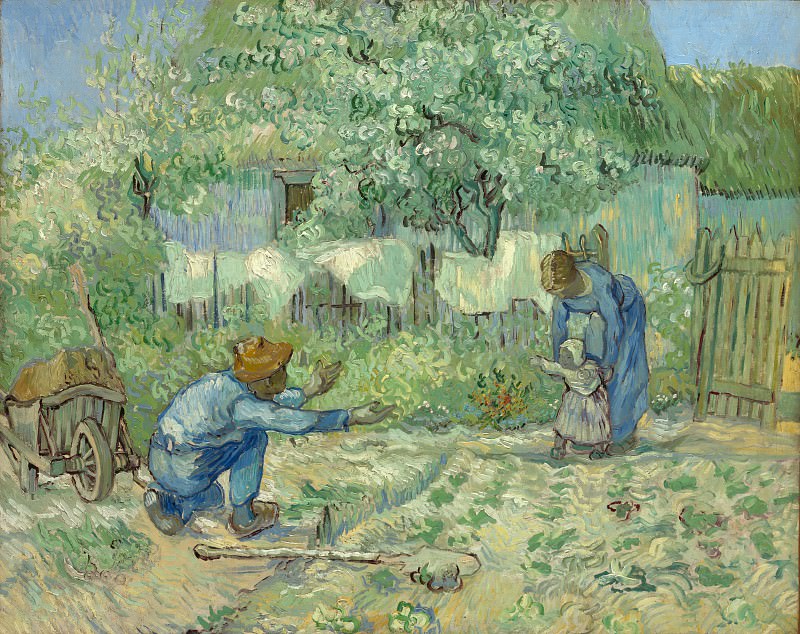Vincent van Gogh – First Steps, after Millet Metropolitan Museum: part 2
Metropolitan Museum: part 2 – Vincent van Gogh - First Steps, after Millet
Edit attribution
Download full size: 3741×2963 px (4,2 Mb)
Back to album: Metropolitan Museum: part 2
Van Gogh eschewed traditional art, and used broad strokes and paints to express pure emotion. This manner of the master set his works apart from other post-Impressionists. He was interested in people, their essence, human feelings. He used free pure color to express the theme. When Van Gogh decided to become a painter, he realized he had a lot to learn. He began to study textbooks on anatomy and perspective, as well as copying works by Mullet, the French artist and founder of the Barbizon school.
A description of Vincent van Gogh’s "First Steps" painting
Van Gogh eschewed traditional art, and used broad strokes and paints to express pure emotion. This manner of the master set his works apart from other post-Impressionists. He was interested in people, their essence, human feelings. He used free pure color to express the theme.
When Van Gogh decided to become a painter, he realized he had a lot to learn. He began to study textbooks on anatomy and perspective, as well as copying works by Mullet, the French artist and founder of the Barbizon school. The budding artist was impressed by the subjects of rural life, the monumental simplicity of the figures, with recognizable poses and gestures.
"First Steps" is one of those subjects that Van Gogh interpreted. Here, we recognize not only man as such, with his misfortunes, hopes, and disappointments, but also a truly profound relationship to art and to the essence of man. There are no superficial judgments in the portrayal of people.
In front of us a man intellectual, spiritual and honest. In the 19th century was born a special theory of color - pointillism, consisting in the denial of a solid tone and the division of the surface into components.
Colorism and painting were freed from the techniques of the past, and replaced by the transfer of the impression and image of objects by means of color, contrast and whole pictorial parts. Thanks to the new theory of color, as if rediscovered its properties and applications.
Here the color speaks for itself, the eye, looking at the picture, itself mixes the colors applied to the canvas. Color occupied Van Gogh more than anything else. It takes on a considerable weight with which the artist conveys his feelings and reactions.
Vincent Van Gogh had his own philosophy of painting, which he likened to music. His colors are thick and rich, but at the same time harmonize with each other on the canvas. The painting is not based on drawing or depicting people, but on the artist’s personal attitude and symbolism.
Кому понравилось
Пожалуйста, подождите
На эту операцию может потребоваться несколько секунд.
Информация появится в новом окне,
если открытие новых окон не запрещено в настройках вашего браузера.
You need to login
Для работы с коллекциями – пожалуйста, войдите в аккаунт (open in new window).




















You cannot comment Why?
The setting is characterized by an abundance of verdant foliage; a large tree dominates the background, its leaves rendered in thick, textured brushstrokes that convey both density and vitality. A clothesline strung across the yard adds to the impression of everyday life, suggesting a cycle of labor and sustenance. The presence of a wheelbarrow positioned near the man hints at agricultural work, reinforcing the theme of rural toil.
The color palette is predominantly green, with variations in tone creating depth and visual interest. Yellows and browns are interspersed throughout, adding warmth to the scene and highlighting specific elements like the child’s clothing or the earth itself. The application of paint is vigorous and expressive; short, broken strokes build up form and texture, contributing to a sense of immediacy and emotional intensity.
Beyond the literal depiction of a family moment, the painting seems to explore themes of nurture, guidance, and the transmission of knowledge from one generation to the next. The man’s gesture – the offering of sustenance – can be interpreted as symbolic of imparting wisdom or providing support. The childs posture suggests both curiosity and dependence, while the woman embodies a protective presence.
The overall effect is one of gentle optimism; despite the implied labor inherent in rural life, there is an underlying sense of hope and continuity. The scene evokes a feeling of connection to nature and the simple rhythms of existence, suggesting a reverence for the foundational elements of human experience – family, work, and the passing down of traditions.